Download Polar Files
- Chart coverage
- GRIB data and presentation
- Internet AIS
- Download polar files
- Social Boating
- Weather Forecast
- Weather Routing
If you don’t want to create your own polar file, download all polar files here >> .
For download: Right click on the file “Save file as”. For more polars, you can also visit jieter.github.io/orc-data/site where you can find polars for almost any boat.
Download All Polar Files .ZIP (304kb)

Polar files for following boats included:
60ftmono.txt 60ftmulti_2.txt 60ftmulti_3.txt
a31.txt a35.txt a40rc.pol akilaria40_rc2.pol alberg35.pol Albin-express.txt Albin-nova.txt alden52.pol amel_54.pol amel_55.pol amel_64.pol amel_euros41.pol amel_kirk.pol amel_maramu.pol amel_sharki.pol amel_supermaramu2000.pol Arcona 340.txt arcona 36 110% + genn D7000 arcona 36 150% + spinn D7000 arcona-370 110% + genn D6200 arcona-370 150% + spinn D6200 Arcona-380 arcona-400 110% + genn D8000 arcona-400 150% + spinn D8000 arcona-400.txt arcona-410 arcona-430 jib+spinn arcona-430.txt arcona-460 150% + spinn Arcona-460.txt
Bavaria Cruiser 33 deep keel rough water.txt Bavaria-38-match.txt bavaria32.pol bavaria33.pol bavaria34.pol bavaria38.pol bavaria44.pol bavaria50.pol Beneteau-44.7.txt beneteau375.pol beneteau421.pol beowulf78.pol blockisland40.pol bountyii.pol breehorn37.pol
c_c34.pol c_c372.pol c_c402.pol c_c44.pol cal-40.txt cal2-46.pol cal239.pol cal36.pol cal40.pol catalina-22.txt catalina-36.txt catalina36.pol catamaran38.pol catamaran54.pol cheoy_lee44.pol class-40.txt class40v2.pol colombia43.pol colombia50.pol Comfortina-38.txt Comfortina-32.txt contessa33.pol crealock34.pol
deerfoot_74.pol deerfoot2_62.pol deerfoot62.pol deerfoot64k.pol Dehler-33.txt Dehler-35-2.00.txt dehler-36.txt dehler29.pol dehler32.pol Dehler34.txt dehler35.pol Dehler36.txt dehler38.pol dehler41.pol Dehler44.txt delphia47.txt Diva-35.txt Dragonfly28.txt dufour 405.txt dufour_sylphe.pol dufour-34.txt dufour-36.txt dufour24.pol dufour27.pol dufour34_1974.pol dufour34.pol dufour4800.pol dufour485.pol dynamic-3000.txt
elan-37.txt elan350.pol elan37.pol elan450.pol endeavor40.pol erickson29.pol etap32i.pol evasion32.pol evasion34.pol express27.pol express37.pol
facil-30.txt Fareast 28R.txt farr-1020.txt farr-36.txt farr-40-mh.txt Farr40.txt farr-52.txt farr36od.pol farr39cr.pol Figaro_1.txt Figaro2.txt finn flyer 36.txt finnflyer-42 club finngulf-33.txt first-10r.txt first-31.7.txt first-34.7.txt first-36.7.txt first-40.7.txt first-40.txt first-47.7.txt first21_7.pol first210.pol first24.pol first25_7.pol first26.pol first27_7.pol first29.pol First30JK.txt first31_7.pol first310s.pol first325gte.pol first32s5.pol first34_7.pol first36_7.pol first40_7.pol first45.pol firstclass10.pol freedom44cb.pol
gibsea442.pol gladiateur.pol grand-soleil-341.txt grand-soleil-37.txt grand-soleil-40.txt grandsoleil341.pol grandsoleil37.pol grandsoleil40.pol grandsoleil42.pol grandsoleil43.pol grandsoleil45.pol grandsoleil46.pol grandsurprise.pol gulfstar50.pol
hallberg-rassy310.pol hallberg-rassy342.pol hallberg-rassy372.pol hallberg-rassy40.pol hallberg-rassy412.pol hallberg-rassy43mklll.pol hallberg-rassy48mkll.pol hallberg-rassy55.pol hallberg-rassy64.pol hanse-400.txt hanse345.pol hanse400.pol hinckley50.pol hunter375.pol hylas54.pol
imocaopen60.pol imx-38.txt imx-40-enl-orc.txt imx-40.txt imx-45.txt irc-32.txt irwin40.pol irwin54.pol islander36.pol
j-111-enl-orc.txt j105.pol j105.txt j109.pol j109.txt j111.txt j120.pol j120.txt j122.pol j125.txt j130.pol j130.txt j133.pol j133.txt j160.txt j30.txt j34c.pol j40.pol j46.txt j70.txt J80-enl-orc.txt J80.txt j88.txt jeanneau41.pol jod35.pol jpk1010.pol jpk960.pol
lagoon380.pol landmark-43.txt landmark43.pol linjett 37.txt Linjett-33.txt linjett-35.txt linjett-40.txt little_hrb_48.pol little_hrb50.pol little_hrb63.pol
maxi_multi_2013.pol maxus21.pol melges-32.txt melges24.txt melody.pol mini_650.pol morgan41.pol multi50.pol mumm-30.txt Mumm-36.txt muscadet.pol
nacira650.pol najad440.pol navy44.pol newport41.pol nf norseman447.pol
oceanis31.pol oceanis34.pol oceanis351.pol oceanis37.pol OE36+.txt omega-10 main jib omega-34.txt
passport41.pol pearson33.pol peterson44.pol platu-25.txt pogo1050.pol pogo40_s2.pol pogo40.pol pogo650.pol pogo850.pol
ranger37.pol rm1200.pol
sabre362.pol sabre402.pol santa-cruz-50.txt santa-cruz-52.e.txt santacruz50.pol santana35.pol scanmar-33.txt Seacart30.txt sense46.pol shannon38.pol shock35.pol small_polar.pol sundeer64k.pol sunfast32.pol sunfast3200.pol sunfast32i.pol sunfast36.pol sunfast3600.pol sunfast39tq.pol sunfast40.pol sunkiss45.pol sunlegend41.pol sunmagic44.pol sunodyssey40.pol sunshine38.pol swan-37.txt swan-42-cs.txt swan-45.txt swan-62rs.txt swan-70.txt swan37.pol swan38.pol swan39.pol swan391.pol swan40.pol swan44.pol swan45.pol swan46.pol swan46cb.pol swan60.pol symphonie.pol
tartan10.pol tartan37.pol tartan40.pol tartan41.pol tayana37.pol tayana42.pol tayana52.pol the_race.pol thompson-30.txt tp52.txt
valiant40.pol valiant47.pol vandestadt_zeehond.pol volvo-60.txt volvoocean65.pol
x332.pol x332.txt x332sport.pol x34.pol X35.txt x35od.pol X362-Sport 2,05m.txt x37.pol x40.pol x402.pol x40carb.pol X41.txt x442.txt x99.pol xc42.pol xc45.pol xc50.pol xp33.pol XP38-DC.txt XP38.txt xp44-dc1.txt xp44-sa1.txt Xp44.pol Xp50-dc1.txt
Yankee38.txt Young-88.txt
- Video Tutorials
- Advantages of Seapilot
- AIS presentation in Seapilot
- App settings and functions
- Chart presentation
- Coastal Forecasts and AIS real-time observations
- GPS and Internet
- Purchase and subscription
- Planned versions
- Press Releases
- Media material
- Mentions in media
- Privacy Policy
Privacy Policy EULA

© 2024 Seapilot AB
Boats & Polars
[vc_column_text pb_margin_bottom=”no” pb_border_bottom=”no” width=”1/2″ el_position=”first”]
Polars & Performance
Below is a collection of polar diagram from various sources.
Mostly in numerical format to easily plug into routing software. They’re published here just to play around with. For serious/real use you should get a real one for your specific boat. Also some links to tuning guides and other perfomance related info. Share and enjoy!
- 1D35 ( North , UK , Quantum )
- 606 ( Gransegel , Hamel , North )
- 806 ( trimguide )
- Albin Express ( Sten Bergqvist , Edman , North , Ottosson , UK Syversen )
- Albin Nova ( Blur )
- Beneteau 25 ( North )
- Capri 22 ( Ullman )
- Catalina 22
- Catalina 36
- Dehler 38/Pacer 376
- Drake ( Høj Jensen , North Tuning Guide )
- Etchells ( Doyle , North , Quantum )
- Farr 36 ( Farr Performance Prediction )
- Farr 40 ( Doyle , Farr PP , North , Quantum )
- Farr 395 ( Doyle , North )
- Fenix ( trimguide )
- Finn Flyer 36 Club
- First 34.7 ( Farr PP )
- First 36.7 ( Doyle , Farr PP , North , Quantum / pdf , UK / pdf )
- First 40.7 polar1 polar2 ( Farr PP )
- First 44.7 polar1 polar2
- First Class 8 ( North )
- H-båt ( Edman , Henrik Lundberg . Høj Jensen , North )
- IF ( Edman , North )
- IMX-40 ( X-yachts )
- IMX-45 jib only
- J/22 ( Haarstick , North , Quantum )
- J/24 ( Doyle , Haarstick , Jardine , North , Quantum , Shore , UK , Ullman )
- J/27 ( Ullman )
- J/35 ( Quantum )
- J/80 ( North , Shore , Quantum , UK , Ullman )
- J/105 ( Doyle , North , Quantum , Ullman )
- J/109 vpp-od / vpp-genua ( Doyle , North , North England , Quantum )
- J/120 ( North , Quantum )
- J/122 ( polar + pleliminary IRC cert )
- J/133 ( vpp )
- Landmark 43
[/vc_column_text] [vc_column_text pb_margin_bottom=”no” pb_border_bottom=”no” width=”1/2″ el_position=”last”]
- Melges 24 ( North , Quantum , Ullman )
- Melges 32 ( North , Quantum )
- Mumm 30/Farr 30 polar1 polar2 ( Doyle , Farr PP , North , Quantum + Cookbook
- Nelson-Marek 43
- Olson 25 ( Scot Tempesta )
- Prima 38 ( Quantum Tuning Guide )
- Santana 20 ( Ullman )
- Soling ( Doyle , North , UK )
- Sun Fast 3200
- Sydney 36CR
- Sydney 38 ( North )
- Swan 42 “ClubSwan” ( North , Quantum )
- Swan 45 ( B&G , Hall . North , Quantum )
- Tartan 10 ( Doyle , North , Sobstad )
- Ultimate 20 ( Ullman )
- X-35 polar1 , polar2 ( B&G , North )
- X-99 ( North , X-yachts )
- X-332 ( trimguide )
- X-332 Sport
- Yngling ( Doyle , Høj Jensen , North , Ullman )
Various sources for IMS ratings with VPP-data:
Just for reference I collected a bunch if IMS certificates here .
I also collected lots of IRC numbers, just for reference. Sorted by boat type and sorted by Time Corrector (TCC) .
Pelle Lindell did some excellent comparisons between LYS, IRC, IMS, ORC Club and PHRF: “ Käpp eller rullator, handikapp för seglare – En jämförelse av olika handikappsystem ” + spreadsheet .
Various sources on trim/tuning (Swedish):
- Bodings lilla röda
- Hamel trimtips
Various polars from Sailinline.org .
- Albin Express
- Bavaria 38 Match
- Comfortina 38
- Dynamic 3000
- Finngulf 33
- Grand Soleil 341
- Grand Soleil 37
- Grand Soleil 40
- X-41 ( assy for pole )
[/vc_column_text]
49 Comments
blur » Blog Archive » Polardiagram Dec 18, 2006 @ 12:17
[…] Jag har sammmanställt en del polardiagram för olika båtar här. Kan vara intressant att labba med om man skall byta båt (eller bara på kul). […]
blur » Blog Archive » Wrap Up 2006 - bloggen Dec 28, 2006 @ 22:18
[…] Sökt på Google: vad är det folk har sökt på när de kommer till blur.se? I fallande ordning ‘Maria Cattiva’ (>500 klick), ‘polardiagram’, ‘Tjörn Runt’, ‘Blur’, ‘x-35′, ‘Albin Nova’, ‘Bengt Falkenberg’, ‘Hermanö Runt’, ‘Gotland Runt’ och över 2.000 andra sökord. […]
Trimguider « Aiming First Apr 23, 2007 @ 22:06
[…] Jump to Comments Her er en liste over trimguider på nett. Les og kos […]
Hi, I went to your Web page looking for polar diagram or data for Tartan 10. I found the tuning guides but not the performance prediction. If anyone has one please let me know.
Thanks, Ron
I also am looking for T-10 polars; are any available?
Hi guys, given that there’s a lot of people from Scandinavia here I figured I’d ask the question; Has anyone come accross the polars for the dJUICE VO60 or any of the other last generation VO60’s. Please let me know,
Hi Euro, I have ORC polar data for VO 60 but only in paper format, so I have to rewrite them and then send it to you.
Please, let me your e-mail.
Peter, Det finnes et ferskt IMS-målebrev for IW 31 FIN 6313: http://www.avomeripurjehtijat.fi/certlist/?boat=L-6313&content=pdf
Jeg har plottet polardiagrammet her: http://iw31.blogspot.com/2007/10/s-fort-br-vi-seile-polardiagram-for.html
Anyone with polars for :
Benateau One Ton ?
Would appreciate it.
I’m looking for polars for an Etap 30. I’m hoping someone across the Atlantic that races an Etap 30 might be able to help me.
Thanks! Carl
Please, is it possible the polars for X-40 with genoa 135% or genoa 105%.
Thanks Lakis
Do you know where I can get a polar diagram for Capri 22?
Noen som kan hjelpe med å tyde polardiagrammet for First Class 8?
I am looking for catalina 38 polar diagrams? Or suggestion how to calculate them ?
any one have a polar or tuning guide for a Delher 22/Dehlya 22? thanks
Any polars/performance for the new First 45 with Carbon Rig and deep keel?
Here are some Dehlya 22 polars from IMS VPP (with oversized 36 m2 spinnaker). Displacement and RM are not accurate, but I found the target speeds to be OK.
The boat is very fast for it’s size and age when the wind is 10 kn or less. In stronger winds it’s speed is limited by the short waterline and the hull form that is very difficult to get out of displacement mode.
TWS, BSP, TWA, BSP, TWA 6, 3.79, 43.9, 3.67, 148 8, 4.63, 43.4, 4.61, 150 10, 4.77, 40.5, 4.81, 165 12, 4.85, 39.4, 5.17, 170 14, 4.91, 38.8, 5.52, 172 16, 4.95, 38.6, 5.80, 173 20, 4.98, 39.2, 6.35, 172
Joakim. Thanks for these figures! As a new owner of a Dehlya 22, I’m interested in the target speeds of my boat. But how can I transfer these numbers into a polar diagram? Do I need specific software for this? Do I read it right as TWS = True Wind Speed, BSP = Boat Speed, TWA = True Wind Angle? As I understand the angles, they represent the wind angle producing the maximum boat speed when tacking, and reaching. But what about the other wind angles?
Eric, you can use a spreadsheet like Excel to present these figures in graphical format. You would of course need the “other” angles too, they are found in the boats ORCc/i certificate – maybe Joakim can help you to find one?
Here are all the data for Dehlya 22. Note that TWA includes leeway. Hope you can read it. I don’t see any use of making the polar diagram. Just pick some values from the table and compare.
Wind Velocity 6 kt 8 kt 10 kt 12 kt 14 kt 16 kt 20 kt Beat Angles 44,0° 43,5° 40,3° 39,1° 38,5° 38,2° 38,5° Beat VMG 2,65 3,28 3,58 3,72 3,81 3,87 3,89 52° 4,15 4,89 5,19 5,38 5,48 5,54 5,59 60° 4,57 5,06 5,37 5,58 5,69 5,75 5,81 75° 4,80 5,35 5,64 5,76 5,95 6,07 6,17 90° 5,00 5,49 5,81 6,00 6,10 6,19 6,46 110° 4,91 5,40 5,76 6,07 6,35 6,55 6,77 120° 4,75 5,28 5,67 5,98 6,30 6,59 7,04 135° 4,15 5,00 5,43 5,77 6,07 6,37 7,01 150° 3,52 4,54 5,10 5,49 5,80 6,09 6,67 Run VMG 3,05 3,93 4,59 5,04 5,40 5,69 6,22 Gybe Angles 147,6° 149,5° 164,6° 169,7° 171,5° 172,9° 172,3°
Polar diagram might come handy, if you are intrested in optimising VMC, on longer offshore legs perhaps…
Otherwise, it’s just as Joakim says, pick your target and compare. You will however have to calculate your target speed: TBS=VMG/cos(TWA). And note also, that in the range 0…10 kn the TBS changes quite rapidly, so the wind (TWS) should also be measured accurately.
Thanks a lot! Now I can compare my performance, and check the best course! As you say, the graph is not necessary, It’s the data I need.. It will help me to improve my sailing :-) Eric
Looking at the data, I’m not sure I understand it all :-( TWA 90° means: wind 30°; course my GPS 120° for example? And: if the wind blows 6 kt, and I sail 90° wind angle, I should be able to do 5 kt? I was comparing the data to the Dutch ORC-data I have for Dehler Sprinta ( http://www.watersportverbond.nl/data/8F2_Sailspeed.xls ), and it is suggested that the Dehlya is faster, allthough smaller??? Thanks again for explaining, and helping me! Eric, Senior; but Junior Racer…….
As I said this data was with an oversized spinnaker, which is actually 38 m2 with the ORC formula compared to 33 m2 of Sprinta Sport, which should do 5,0X kn at 6 kn 90 (checked two boats).
Even with a more typical spinnaker of 28 m2 the Dehlya 22 should do 4,89 kn at 6 kn 90. As I said it is a very fast boat for its size and age in light winds. Size doesn’t count that much in light winds and you should be able to sail faster than many bigger boats at 6kn.
Any polars for a mumm 36?
4 or 5 at http://www.ssf.se/tk/pdf/cert2008.asp
Hej! Nu finns det polardiagram för Beneteau First 32s5 här http://www.sailstarck.com/Forum/tabid/53/mid/369/threadid/7/scope/posts/Default.aspx#43
Noone has any polars or tune details for the Beneteau First 45 with carbon rig and deep keel ?
I’m looking for polars for X 40 (1985) with 120% genoa. Who can help me? 11 Lakis: have ever had an answer? Thanks, Frank
I’m sorry, I mean 130% genoa (N° 29)
Thanks for the Dehler 22 info the boat is very quick in light air
Does anyone have polars for Scampi Mark IV.? Help.
Any polars for First Class 10????
Good Morning,
Any polars for a Bavaria 34, long keel, year 2000 manufacture?
Bernard Bodin
Joakim you state that a Delher 22 is difficult to get out of displacement mode could you give an explanation and ideas on optimizing for this condition. thanks
What kind of optimiazation are you talking about? The hull form is not designed for semiplanning speeds, thus it needs big waves to get over 7 kn and still the average speed will be below 7 kn. At least I was newer able to sail faster than 7 kn for more than a couple of minutes or so and that was in ~15 m/s wind with the big spinnaker.
I have not had the opportunity to sail my boat in strong down wind condition but other than a rather fine entry and the stub keel it would appear that it should be quite easy to sail fast down wind. I calculate a D/L of under 150. I was wondering if it is worth raising the keel or using a masthead chute. As this is a rare boat here in the states there is not much in English to go on. I rate in PHRF 234 which is very generous when looking at how fast the boat is in light conditions but not sure if it’s worth the penalty for a larger chute. My boat is rather bare below so no excess weight . Thanks for you response my blog for the boat is http://mysorellina.wordpress.com/ I also race on a Kirby 25
I think the D/L-ratio is close to 200. The waterline is about 5.5 m and the displacement in sailing condition (without crew) likely around 1,2-1,3 tn. I did never put my Dehlya on a scale, but I did quite a lot of queries from the German owners and ended up estimating my Dehlya to 1,3 tn. The official value is 950 kg (or even 900 kg), but it is not clearly stated whether it contains the 200 kg of water ballast. But then using the official WL of 5.2 m with 950 kg ends up close to 200 as well. Thus it is not a light boat! Or have you better knowledge of the displacement?
I don’t know much about PHRF and the fleet is very different here, but picking up some familiar boats 234 sounds very easy to sail to: http://www.ussailing.org/phrf/Tool_%20HI_LO_AVG%20Report.pdf I had a LYS of 1.02, which meant I needed to be 2% faster than Albin Vega, 1% faster than Avance 245 and equal to Beneteau First 24. With that rating I did well under 5 m/s and lousy over 6 m/s.
Sure it might help to lift the keel, but it takes quite long and also reduces stability quite much, thus not very safe when it blows. The mast has quite a long unsupported part and putting masthead chute to that needs some care. The boat does not carry well a big chute when it blows.
Instrument & routing på 5 kvällar | BLUR Jul 25, 2009 @ 22:51
[…] svensk segling och kappsegling Skip to content HomeBoats & PolarsAlbin NovaJ/109Gallery 2007Gallery 2008RacesFærderseilasenGotland RuntSkagerrak TwoStarTjörn […]
Yacht polars | Purepassionbyk Jun 12, 2012 @ 23:02
[…] Boats & Polars | BLURPolars & Performance Below is a collection of polar diagram from various sources. … For serious/real use you should get a real one for your specific boat. […]
Polar Files | RudderNut Jun 25, 2012 @ 16:40
[…] files for various boats can be found on the internet. Here is an example file Catalina 36 from the http://www.blur.se site. The file is text, and though this example has a “.txt” extension Tack Pad […]
Polar Tables - SailNet Community Nov 20, 2012 @ 01:40
[…] Polar Tables Not much help to the OP, but here's a site with quite a list: Boats & Polars | BLUR __________________ ".. there is much you could do at sea with common sense.. and very […]
Understanding the Polar Diagram - Page 2 - SailNet Community Nov 10, 2013 @ 17:53
[…] image while searching Polar speeds, look at manufacturers boat catalogs, on site like this one> Boats & Polars | BLUR On a ORC certificate you will not get a polar but something similar to what Bob Perry posted about […]
Appar sjöväder och prognoser - tips för seglare Mar 17, 2016 @ 09:33
[…] Vilken är högsta farten på alla bogar i alla vindar? Två bra källor till polärdiagram är: http://www.blur.se/boats/ och http://www.orc.org/index.asp?id=1 (där man behöver logga in och ibland betala för […]
I’m looking for Polars for a Cal 35 MK1
Hey Matt, any luck to find them? Im looking for the same Polars
Hi. I´m Fernando from Argentina. I have a J/24 I am looking for the J / 24 polar chart.
Here in Argentina we sail with jib 0% and a maximum crew of 340kg. So, the polars that I need would be with jib and not genoa. Do you have the information? Thank you very much.
Fernando & Crew.
Any information for Sprinta Sport? An E.G. Van derStat one design built by Dehler. Thanks.
Hi just wondering if anyone has come across the polars for Sun Odyssey 389 standard keel
Leave a Reply Cancel reply
Your email address will not be published. Required fields are marked *
This site uses Akismet to reduce spam. Learn how your comment data is processed .
- Boat Reviews
- Press Releases

Understanding Polar Diagrams: Sailing by The Number to Maximize Performance
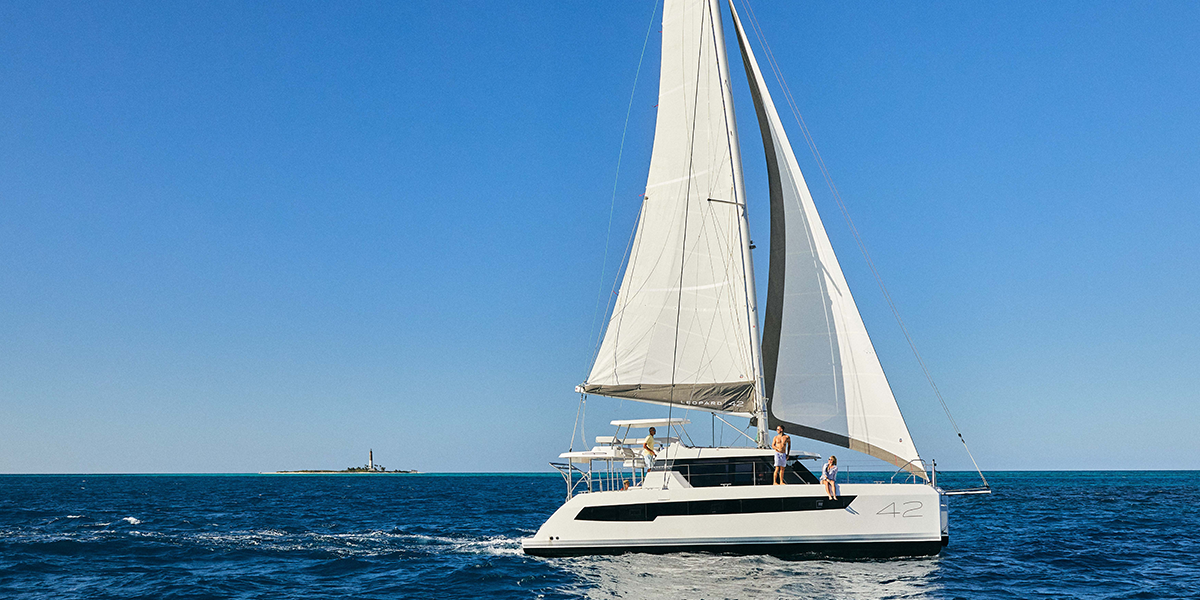
Remember studying for that high school math test and wondering why you had to learn stuff that you would never use again?
Well, surprise! It turns out that math is at the very heart of the sailing experience. Indeed, your Leopard is essentially a massive collection of calculations and equations slicing through the water.
TSW, TWA and VPP
Perhaps the most helpful bit of seafaring math to understand is your Leopard’s polar diagram. A polar diagram shows how fast a sailboat could potentially travel at different wind speeds (TWS=True Wind Speed) and various angles to the wind (TWA=True Wind Angle). Every sailboat model has a unique polar diagram, which displays the results obtained using a velocity prediction program (VPP) based on the craft’s weight, hull shape, rigging and sail setup.
You can find your Leopard’s polar diagram below:
Link to Leopard 42 polar diagram
Link to Leopard 45 polar diagram
Link to Leopard 50 polar diagram
The calculations represented in your boat’s polar diagram are a powerful tool for charting a course, estimating passage times, and choosing your sail plan for maximum efficiency.
Choosing the right sail
"The polar is an excellent way to answer the question, should I still be sailing with a jib, or should I switch to a spinnaker or a reacher,” says yacht designer and naval architect Alexander Simonis. “Everybody knows that when you sail downwind, the jib is not that efficient. You go to a spinnaker, an asymmetric spinnaker, a gennaker, as a downwind sail. But when you want to know something more specific, such as, what sail is best on a reach in 25 knots of wind? Or should I switch now to another sail? That’s where the polar can help.”
Following the polar diagram correctly
While a polar diagram can look daunting at first glance, it’s actually pretty simple to follow.
A polar consists of three data indicators — straight lines, circles and curves. The straight lines that radiate out from the center represent the True Wind Angle (TWA). The circles, which also spread from the center, represent boat speed through the water (STW).
The colored curves, overlaid on the grid created by the straight lines and circles, plot the boat’s predicted speed at various combinations of TWS and TWA. The colors represent different sail plans.
The diagrams are usually divided into upwind and downwind sections.
.jpg?width=1286&name=Leopard%2045%20(1).jpg)
To read the Leopard 45 polar diagram shown here, start by looking at one of the colored curves — say the blue line, which tracks the mainsail and jib sail plan. As you trace that curve through different TWAs, you can see the predicted boat speed with that sail configuration. At 50 degrees TWA, for example, your Leopard 45 should be making 10 knots. At 120 degrees, the boat should travel at 12 knots.
If you’re not making those speeds, your sails may need to be trimmed.
Keep the data close
The velocity prediction data displayed on a polar diagram can also be presented in table form. One way to get maximum use from data is to laminate a copy of your VPP table and post it near the helm for quick and easy reference.
According to Simonis, the popularity of using polar diagrams has only recently increased with recreational sailors. Why? Maybe it’s another example of how we’ve come to embrace the power of data in our lives.
Or maybe math teachers are just doing a better job of selling their subject.
Topics: FAQ
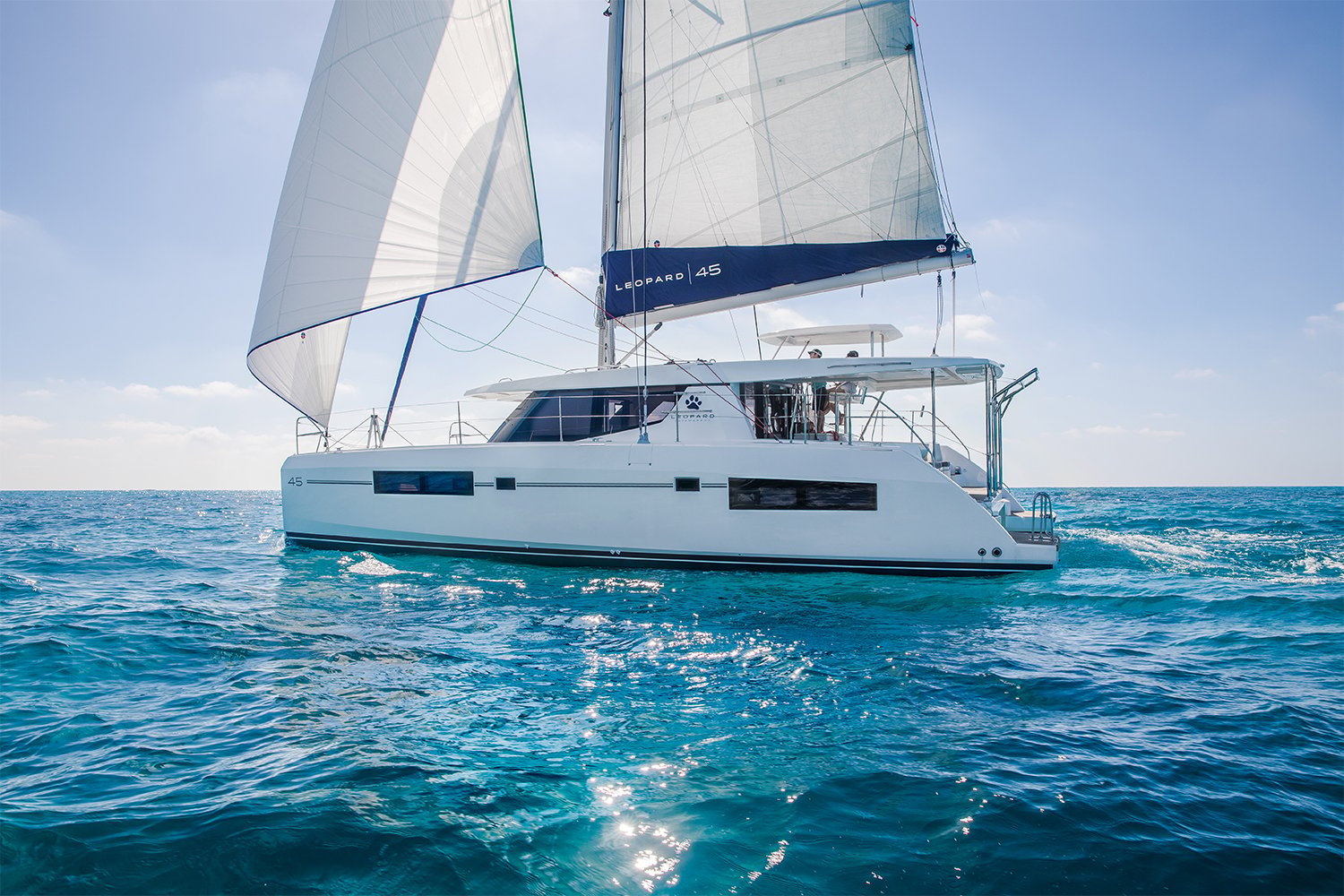
Leopard Catamarans
Subscribe here.
David Burch Navigation Blog
Notes on marine navigation and weather
Tuesday, February 22, 2022
Introduction to polar diagrams and optimum vmc.
A polar diagram is a graphic presentation of a sailboat's sailing performance in various wind conditions. The same information is also often presented in the form of a table or spreadsheet, which is how the data are originally collected or computed, which in turn is then plotted on a polar diagram as shown below. Programs that compute this data are called velocity prediction programs (VPP).

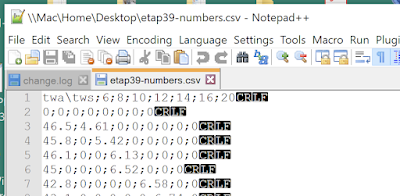
macdavid@iMac Downloads % cat -e etap39.csv twa\tws,6,8,10,12,14,16,20^M$ 0,0,0,0,0,0,0,0^M$ 46.5,4.61,0,0,0,0,0,0^M$ 45.8,0,5.42,0,0,0,0,0^M$

No comments:
Post a Comment
- Yachting World
- Digital Edition

5 tips on developing your polar diagrams to improve your boat speed
- May 25, 2016
To help minimise your losses you need to sail your boat to its target boat speeds. Jonty Sherwill asked designer Mark Mills for his tips on polar diagrams
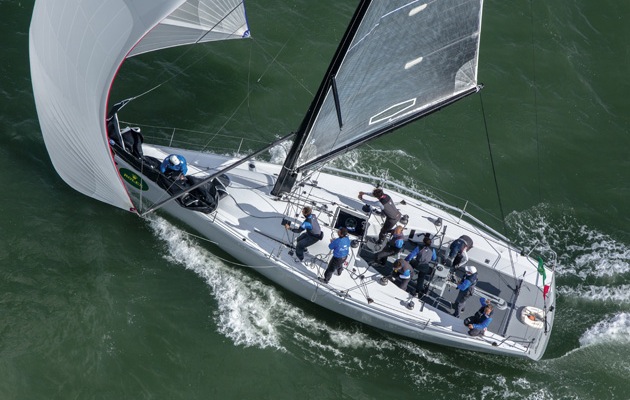
© ROLEX/Daniel Forster
Sails are fresh, the bottom is clean, there’s a good crew, but you’ve been losing out to similar boats on the downwind legs. The helmsman is sailing as close as possible to the target speeds displayed so why is it not doing the trick?
But who sets these target boat speeds and why do you sometimes fail to match them and at other times do so much better? Most of us are familiar with polar diagrams showing a boat’s potential speed on each point of sailing, but how do you put this information to good use?
For those who sail dayboats or small cruiser-racers without a log or wind instruments, judging speed and sailing angles is largely intuitive, as you observe the progress of other boats around you. An electronic compass and depth sounder may be as high-tech as it gets.
Although this ‘seat-of-the-pants’ ability remains an essential part of sailing larger yachts, the information made available by more advanced electronics provides a far better understanding of how the conditions are affecting performance.
Even if the boat has top-of-the-range instruments and came with a set of polars from the designer or an ORC rating certificate this will be just a starting point. Some budget electronics packages won’t provide target boat speeds from within the software, but this doesn’t prevent you developing your own data.
Either way it seems there’s no quick fix and if someone’s bragging how they always sail faster than their targets, good sailing may be part of it, but it’s just as likely to be that the instruments need calibrating and time should be spent developing the polars.
2. Calibration is king
There is no point in having targets if your boat speed is inaccurate. Good instrument calibration is vital, a daily task on top-level raceboats where crew are looking to get within +/– two per cent accuracy.
It’s unlikely many club level racers get consistently close to this target without regular calibration checks, yet what would people say to a designer claiming targets not even accurate to +/–2%?
The calculations that even the most basic system carries out rely on inputs from the log, compass and masthead wind sensor so the calibrations for each should be checked at least at the start of each season and probably more often.
2. Don’t believe the VPPs
Basic parametric VPPs (velocity prediction programs) often used to generate target boat speeds or ORC handicaps are not particularly accurate when compared with programs used for grand-prix boats using CFD (computational fluid dynamics) to simulate the flow of water around the hull. They may be under-predicting, so don’t be satisfied just because you are ‘sailing to targets’.
Also be very sceptical of comparing new models based solely on targets; you have no guarantee that they reflect the actual boat being considered.
3. Theory to reality
Even if very high-quality, a set of polars can only reflect the computer model they started with, and express it in a set of targets unique to that boat. A different displacement, sailplan, alloy or carbon rig, shallow or deep keel type, or crew weight, will lead to more or less different results.
If the targets weren’t created for your boat and configuration don’t expect too much from them, though they may be a good starting point. Output varies from program to program, and remember they aren’t set in stone, so amend your targets.
4. Good sailing
Even the best polars and instruments cannot substitute for natural sailing ability and, by getting to know your boat, you can build an invaluable guide for the helmsman and trimmers just from your own data.

Having good targets on a laminated sheet in the cockpit can put you in better shape than many more expensively equipped boats. However, eyes out on the racecourse and the competition is often more valuable than eyes down on the instruments.
5. Build your own polar diagram
Either start with targets for something similar or note your own performance expectations based on experience (eg, ‘7.2 upwind in 18kn is about right’) and then start paying attention and updating those numbers as you learn what works better – that’s what the pros are doing.
To establish a basic set of polars for your boat there are tablet apps (eg, iPolar) that can provide a starting point and, by noting actual performance from the log (boat speed, not GPS), a pretty accurate set of targets can be developed during the season for a range of wind conditions and sea state.
Mark Mills is a designer well known for winning designs such as Mariners Cove, Tiamat, Alegre, and production designs such as the King 40 and DK 46. Originally from California, Mills studied yacht design at the Southampton Institute, before launching his first design, Aztec, in 1996. Now based in Ireland, he was named 2009 Irish Sailor of the Year for ‘exceptional achievements’.
Create hyper-accurate polars using AI
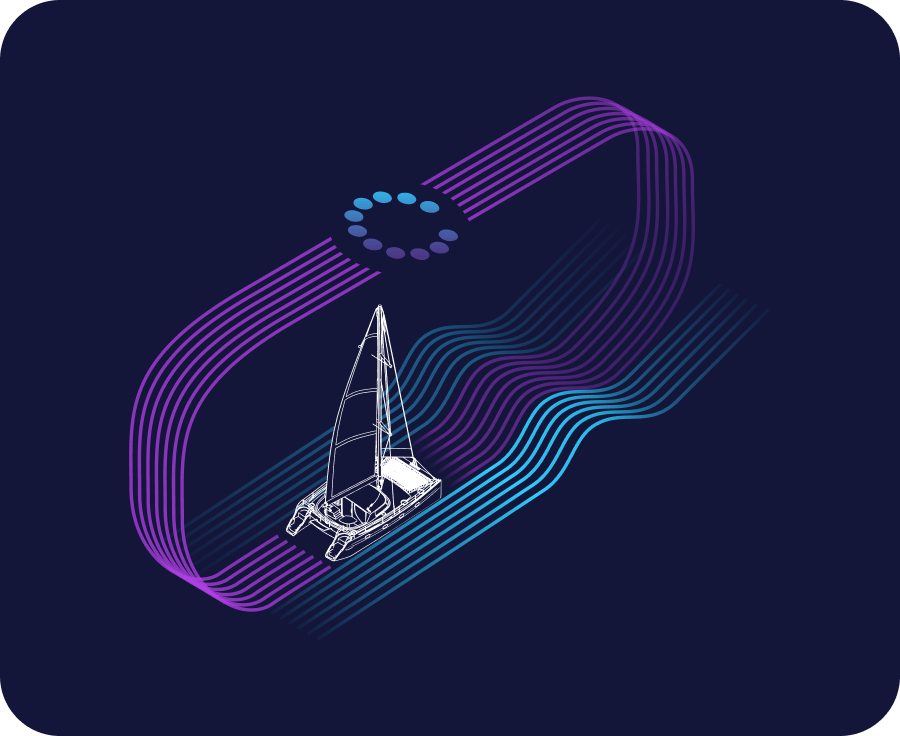
Polars explained
Boat polars represent the performance of your boat in different wind and wave conditions and are critical to creating accurate weather routing results.
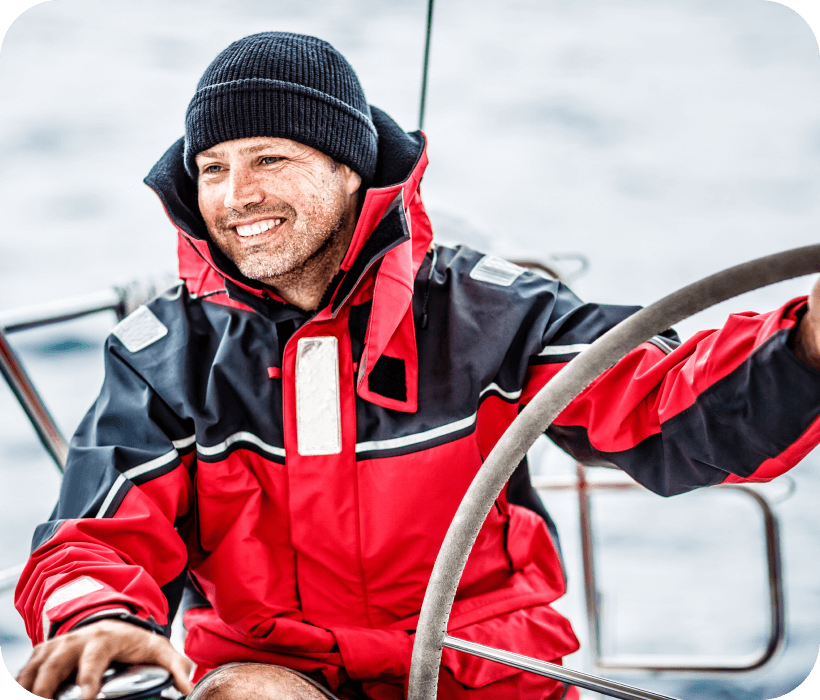
Automated AI Polars
Our new AI Polars reference real-time data to learn the way you sail your boat, to create hyper-accurate weather routing.
Up until now this was limited to the realms of professional navigators. PredictWind now makes it simple and easy to get accurate, personalised polars for your boat. This ensures your boat’s location matches the predicted weather route, resulting in a more accurate forecast.
How it works
Simply plug in the PredictWind DataHub to your boat's instruments and turn on the automatic AI Polars. PredictWind will then track your boat’s real-time data and automatically create an optimised boat polar for your unique vessel and sailing style.
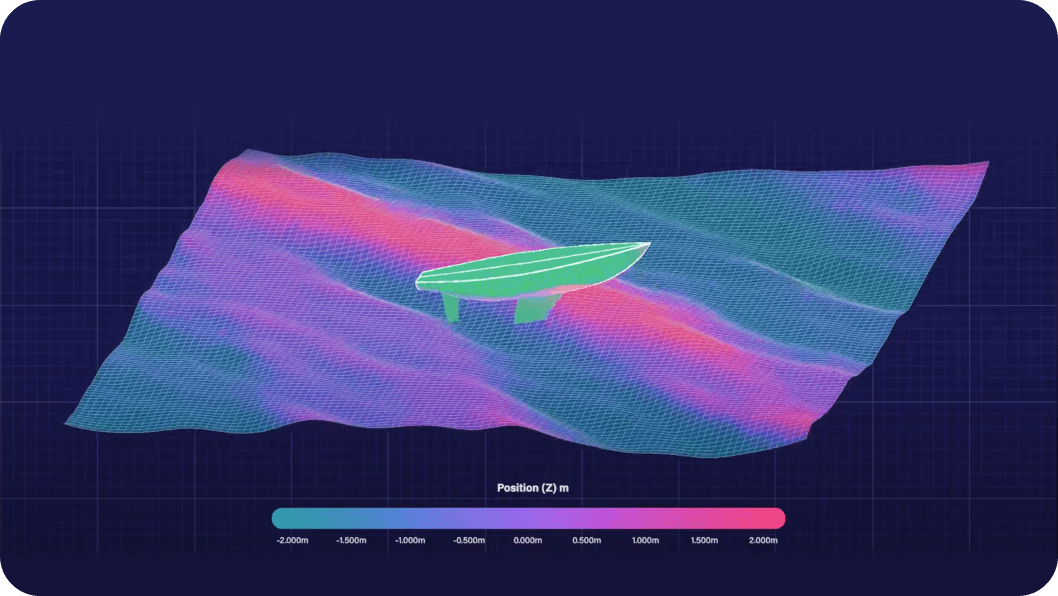
More than just wind
AI Polars also factor in wave conditions (wave height, period & direction) to create a hyper-accurate polar that is a realistic representation of the boat's offshore performance. Accurate polars are critical for giving the most accurate routing on earth.
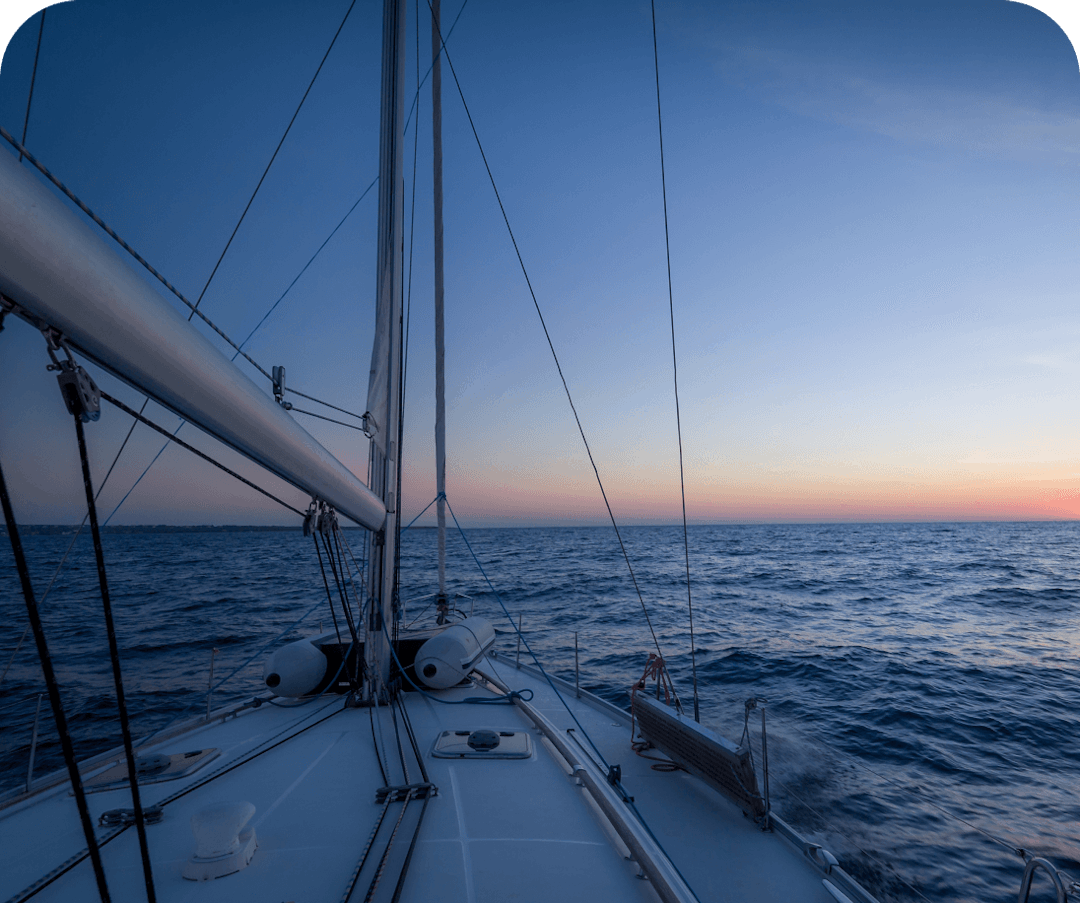
Night Polars
AI Polars will adapt to the unique way you sail at night. Typically, sailing at night will mean reduced speeds, as we sail more conservatively and it is harder to sail at optimal levels. AI Polars analyses how you sail at night and factors this in to your polar data, providing the most accurate polars for day and night.

HOW DO POLAR PLOTS WORK ON A SAILBOAT?
This is an excerpt from the NauticEd Electronic Navigation Course . The course is FREE when you buy the Bareboat Charter Master bundle of courses. Or a la carte, it is only $25. In this section, we are discussing Max VMG – that is the Max Velocity Made Good towards an upwind or downwind destination, the optimum true wind angles to sail, and how to use polar plots to attain these important numbers.
The polar plot is the navigator’s friend. It’s essentially a graph that shows how fast your boat can go in a range of wind speeds and angles. Polar plots are published by each manufacturer for each model of boat with their various sail plans. Below is an example of one particular boat for three true wind speeds; 16 knots, 12 knots, and 8 knots.
HOW TO READ A POLAR PLOT
Move your finger radially along any true wind angle. Stop when you reach the boat performance line associated with the true wind speed you are experiencing. Now, read back around the concentric boat speed circles to the vertical axis and read off the expected performance boat speed (through the water) for that given true wind angle and that given true wind speed. This is the speed at which your boat “should” be sailing and is the speed to which your sail trimmers should try to achieve: the target boat speed.
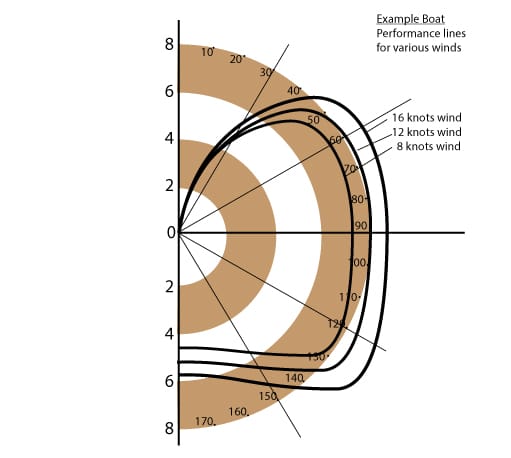
For example: If you were traveling at 60 degrees off the wind, below would be your boat speeds (through the water) at the various wind speeds:
- 16 knots wind: 8.8 knots boat speed
- 12 knots wind: 8.2 knots boat speed
- 8 knots wind: 7.2 knots boat speed
Observe the following animation. Click on any TWA (true wind angle) on the right and watch:
- The boat icon move to that position on the polar plot
- The wind meter boat speed and TWA
Additionally, what is great about this is that the optimum true wind angle for upwind and downwind legs are easily found by drawing a horizontal line at the highest polar point for upwind and the highest for downwind. In this case, you are maximizing your VMG (Velocity Made Good in the direction of the true wind).
In the plot below, for the 12-knot wind speed example, the max VMG is 5.2 when the boat is properly trimmed, sailing at 7.4 knots through the water and sailing at 45 degrees off the true wind. When sailing at any other angle, the VMG will decrease. If you sail closer to the wind, you are sailing a better angle but your VMG drops along with your boat speed. If you “crack off” the wind a little, your boat speed goes up but your VMG decreases because you are sailing a worse angle. For an upwind course then, the optimum true wind angle for the boat is the highest point the curve reaches because you are maximizing your VMG in the upwind direction.
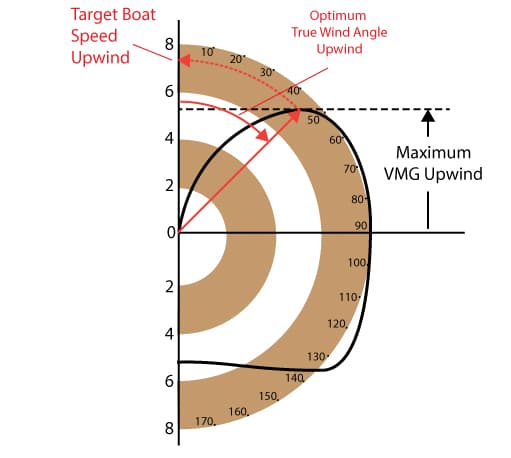
In this example, when sailing upwind, the optimum true wind angle is 45 degrees (aka Target True Wind Angle ) and the Target Boat Speed is 7.4 knots. Thus, upwind, the navigator calls to the helms person to steer 45 degrees to the true wind and tells the trimmers to trim to attain 7.4 knots of boat speed through the water (not SOG).
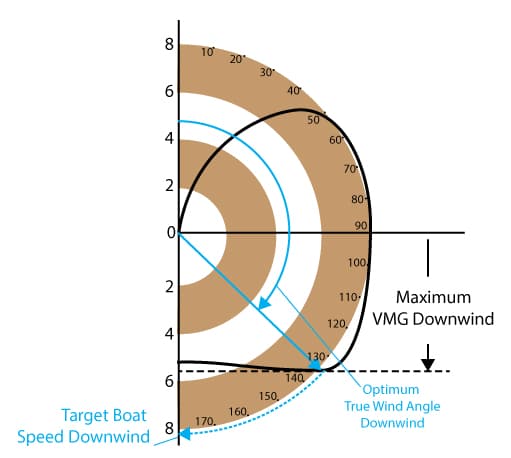
Downwind, the optimum (target) true wind angle is 135 deg and the target boat speed is 8.1 knots.
It can be easily determined from the above plot that a downwind heading to a downwind destination is not the fastest way to get to the downwind destination, instead, head off a little and do several gybes. But how much to head off?
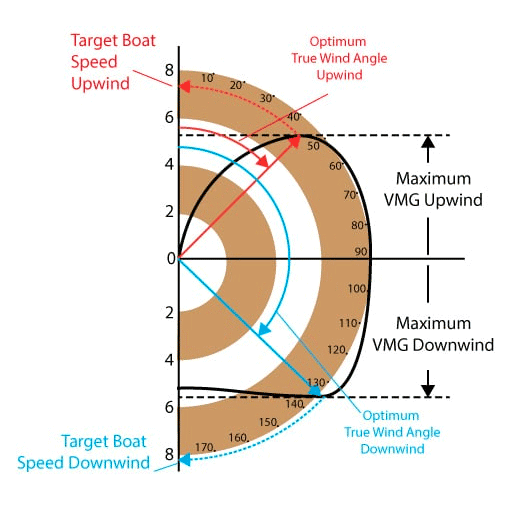
In the polar plot example shown, a horizontal line that touches the max boat speed touches at 135 degrees. At this point, reading around the concentric circle, the boat speed is 8.1 knots (assuming it is properly trimmed). Reading across to the vertical line the VMC is 5.7 knots. Comparatively, another sailor that takes a course directly downwind would achieve a boat speed and VMC of 5.0 knots.
In the video below, we sail the boat at specific angles and measure the speed. Then we compare those speeds with the polar plot of the boat. We also show you through a polar plot so that you can exactly understand how one works.
If you’re getting stuck on this a little, don’t worry too much. The two main points to understand are the optimum upwind true wind angle and the optimum downwind true wind angle.
Some units have built-in example polar plots which you can change and add to match your boat. Although, you might ask your installation specialist to input these for you.
To learn more, register for the NauticEd Electronic Navigation Course ›
### Updated 11/23/2022
Bareboat Charter Master Course
Become a Bareboat Charter Master - a comprehensive online course for multi-day near coastal sailing and bareboat chartering internationally.
Start with 2 Free Sailing Courses
Sign-up and get 2 free courses and a free sailing eLogbook to build your sailing resume for charter companies worldwide.
- Recent Posts
- Sailing Grenada and St. Vincent and the Grenadines - May 14, 2024
- Getting a Sailing Qualification while on a Sailing Vacation - April 24, 2024
- RYA Day Skipper with NauticEd - April 1, 2024
You might also like

TWEET ABOUT

FIGHT CHILDHOOD CANCER
NauticEd is a fully recognized education and certification platform for sailing students combining online and on-the-water real instruction ( and now VR ). NauticEd offers +24 online courses , a free sailor's toolkit that includes 2 free courses, and six ranks of certification – all integrated into NauticEd’s proprietary platform. The USCG and NASBLA recognize NauticEd as having met the established American National Standards. Learn more at www.nauticed.org .

The NauticEd Vacations team are Expert Global Yacht Charter Agents – when you book a sailing vacation or bareboat charter through NauticEd, we don’t charge you a fee – we often save you money since we can compare prices from all yacht charter companies. PLUS, we can give you advice on which destination or charter company will suit your needs best. Inquire about a Sailing Vacation or Charter .
Online Sailing Courses Sailing Vacations | Charters Practical Sailing Courses Sailing Certification | License
Sign up for 2 FREE Sailing Courses Try sailing in Virtual Reality! Gift a Friend a Sailing Course Sailing Events | Opportunities
About NauticEd Contact Us NauticEd Support Privacy Policy
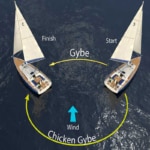
- AROUND THE SAILING WORLD
- BOAT OF THE YEAR
- Email Newsletters
- America’s Cup
- St. Petersburg
- Caribbean Championship
- Boating Safety

Take Your Polars Offshore
- By Stan Honey
- Updated: June 3, 2008
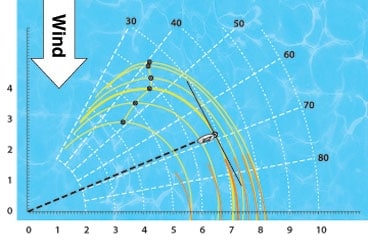
In the April ’08 issue we covered how to use your boat’s polar data and target boatspeeds to get to the next mark more efficiently. This month we’ll look at applying the same concepts to an offshore race, where the marks are farther down the course and there are a few more variables to contend with.
Let’s assume you’ve done your prep work and have your target cheat sheet posted in the cockpit and at the nav station. The trimmers and helmsmen are all on the same page. Everyone’s goal is to get to the finish as fast as possible. Your tactician or navigator will have already entered target waypoints into his routing software to best take advantage of projected and current weather conditions.
A common offshore strategy is to maximize your boatspeed to that next “mark.” We call this velocity made good to course (VMC). As it was for your buoy race, the polar curve you’ve gotten from your designer, or with US SAILING’s Performance Package, is a useful graphical tool. You can make a transparency of the polar plot, center it on the boat position on your chart, and align its vertical axis with the wind direction. If you then create a line perpendicular to the rhumb line to the next mark, shift the line until it is tangent to your polar curve. This will show you the wind angle that gives the greatest vector component in that direction. As shown in the diagram at right, this is easy to do with a pair of drafting triangles.
In our example, the rhumbline direction is 60 degrees. The solid black line is perpendicular to 60 and tangent to the polar curve at approximately 69 degrees. This is your heading to maximize VMC. You will not be heading directly to the mark, but somewhat further off the wind. The tactical expectation is that with all the wind shifts likely to occur over the course of this leg, opportunities will arise to compensate for not heading straight to your mark.
Calculation of optimum routes The most prevalent offshore use of polars is in conjunction with gridded binary weather data (GRIB files) to compute the optimum course for your boat. Software packages commonly used for this application include Deckman for Windows, Expedition, and Maxsea.
The polar file used with your routing software should reflect the boat’s actual average performance, including the fact that in light air offshore there is often a sloppy sea state, and in heavy air the boat is often sea-state limited and cannot be pushed above a seamanlike speed upwind in the typical sea-state associated with heavy air. Further, the boat’s average performance includes the full mix of helming skills, not just the performance of the best helmsman. So the polars you use for routing will end up being a separate file from your target polars. The routing polars need to be achievable. If you run a route on a GRIB file, and it turns out the first four days of the GRIB file forecast are accurate, in four days the boat actually needs to be exactly where the router calculated it would be. If your polars consistently overestimate your boat’s performance, and you don’t actually get to where the router calculates you will be at various times in the future, then the calculated route will not be relevant for your boat, and the routing software will be “playing” shifts you will never experience. There are, however, many pitfalls in computing optimum routes from polars. Lets look at them individually.
The weather forecasts (GRIB files) are not perfect. A typical GRIB file from the U.S. Global Forecast System (GFS) will contain forecast data extending out 15 days. The GFS data will be good for the first four days or so, but is less accurate further out in time. The routing algorithms don’t consider this decreasing certainty of the forecasts with extended forecast time. So, if you take a 15-day GFS GRIB file, and compute a transoceanic passage, you may find the router recommends an unconventional route based on the weather pattern that is forecast 10 to 15 days in the future. You know, but the router does not, that the 10- to 15-day forecast is much less certain than the forecast from 0 to 5 days. So the human navigator has to provide “genuine intelligence” (as opposed to the router’s artificial type). The human navigator has to consider the standard meteorological patterns and work out where you want the boat to be five days into the future based on standard climatology. The routing program can do a very nice job of optimizing how to play the near-term weather patterns to best get there.
Routing programs don’t adjust their computed routes for risk. For example, if there is a light-air area (e.g. high pressure) in your way, the routing program will skirt the area of calm very closely to minimize distance sailed. The routing program doesn’t consider that if the forecast is slightly wrong you could be becalmed, whereas sailing a few miles extra distance to position the boat slightly farther from the high could substantially reduce the likelihood of becoming becalmed due to an inaccuracy in the forecast. Some folks address these problems by editing the boat’s polars to artificially reduce performance in light and heavy air. That is one approach, but it has the disadvantage of causing the routing program to work less well in situations where you are forced to sail in light or heavy air. In such situations, if the polars do not reflect the boat’s actual performance, the router will not accurately estimate the boat’s future position and will calculate erroneous routes as a result.
So one of the most helpful uses of polars is the calculation of optimum routes, but the navigator must only use the router as a tool. It is still up to the navigator to consider the risks of the calculated route (very light air or very heavy air), and to consider the increasing uncertainty of the forecast with time. Often the best use of computer routing is for the navigator to calculate the route and then work with the router, trying different starting times, trying different sets of polars, putting in various artificial waypoints to force the route into a different area, and working out the estimated time en route (ETE) for various courses so that the navigator ends up with a clear intuitive understanding of what the weather is doing, what the best route is, why that is the best route, and how much better it is than the alternatives. The objective is for the navigator to completely understand the trade-offs and risks of the various routes in order to make a reasoned decision.
One technique to quickly understand the nature of the optimum route is to set up the routing software to display the forward and reverse isochrones. Take a look at the diagram above; the forward isochrones plot the locus of all the points, for each hour in the future, where the boat could be depending on the path it sails. So the forward isochrones are a family of curves surrounding the boat’s starting location. The reverse isochrones plot the locus of points for each hour prior to the boat’s expected arrival at the destination waypoint. When the forward and reverse isochrones are both plotted, the navigator can tell by inspection how important it is to sail the optimum route. If the forward and reverse isochrones run parallel to one another for a section of the course, for that region there is lots of flexibility in course selection that can be used to take advantage of local shifts or to cover competitors. If the forward and reverse isochrones just touch each other like the center of a figure eight, then according to the routing algorithm, it is important to take the optimum course. In this situation it is critical for the navigator to have a complete understanding of what weather characteristics are causing the optimum route to be so critical.
It is often useful to calculate the heading to sail to achieve the maximum instantaneous closing velocity to the next waypoint. If you know the wind will not change, you are better off pointing directly at the waypoint if on a reach, or sailing your VMG target angles and tacking or jibing if you are on a beat or run. If you are confident in the forecast, then you are better off calculating a route with your polars and the forecast GRIB file. If, however, you are sure that the wind will be shifty but you don’t know how and when, then it makes sense to sail whatever heading achieves maximum instantaneous closing velocity to the mark. This can be the case in light air when the wind is wildly shifty, or in locally turbulent conditions when no forecast makes any sense. You just shrug and do whatever you can to maximize your closing rate to the next mark. The logic is that all else being either equal or unknown, you might as well get as close to the mark as you can.
This calculation of the heading to achieve maximum VMC to the mark with the present wind direction and speed can be done from polar data by many instrument systems, by routing software packages, or can even easily be done graphically using the polar curves that come with the US SAILING Performance Packs. Instructions and examples are included with the Performance Packs.
Even on long offshore legs when you are sailing a computed route from GRIB files, it often makes sense to refer to the optimum VMC angle. If the boat’s heading is not between the direct course to the waypoint and the optimum VMC angle, it is important for the navigator to understand exactly why that is. Having said that, there are certainly reasons to sail courses that are outside the VMC angle; the first third of the Transpac nearly always requires such a course.
Performance assessment As described earlier in this article, when beating or running, the target table provides a good reference for the boat’s performance. If the boatspeed is not very close to the target values, that is a wake-up call to the crew to work out why. Maybe the boat isn’t trimmed correctly, maybe a sail change is necessary, maybe the boat has weed on the keel or rudder, or sometimes there is an unusual wind sheer or sea state causing the discrepancy. To assess performance on a reach you have to use the polar tables themselves. Many instrument systems can display on deck a reaching performance percentage number. This is simply the current boatspeed displayed as a percentage of the boatspeed predicted by the polars for the same conditions.
Just as with the target table when beating or running, this percentage performance number can provide the crew with a rapid indication that the boat is underperforming. If your crew is more able to quickly detect a trim, sail selection, or weed problem than your competitor, you will enjoy a significant advantage. This is particularly true when you are racing offshore or at night and cannot easily compare your performance to nearby similar boats.
- More: Sailing How To , Tactics
- More How To
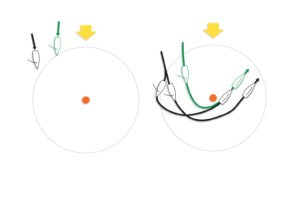
A Guide to Tactical Risk Management

The Wisdom of Augie Diaz

Why S-Turns, Roll Jibes and Roll Tacks Are Fast

The Path to Consistent Boatspeed

Luna Rossa’s New AC75 Marks Its Silver Age


Emirates Team New Zealand Splashes Defense Yacht

Wanderers of the Wayfarer Dinghy

Alinghi Red Bull Racing First to Reveal Its AC75

- Digital Edition
- Customer Service
- Privacy Policy
- Cruising World
- Sailing World
- Salt Water Sportsman
- Sport Fishing
- Wakeboarding
Marine more Grasshopper Widgets
Sailing Polars, AWA, AWS and VMC
Rhino grasshopper.
This widget illustrates AWA (Apparent Wind Angle), AWS (Apparent Wind Speed) and VMC (Velocity Made good on Course) using a boat's polar data. Interactive dials and sliders adjust TWD (True Wind Direction), TWS (True Wind Speed), Heading and Course (bearing to next waypoint).
- TWD/TWS are dark blue
- AWA/AWS are light blue
- boat heading/speed are green
Notice as you change heading how the green arrow always follows the yellow line, precisely.
- TWS slider to choose wind speed from polar data.
- Set TWD, Course and Heading by compass bearings.
- Reads polar data from .csv files; two samples included as "Internalized data": a 32' proa and a Mumm 30 monohull.
- Two sample hulls included as "Internalized data" (proa and mono), or supply your own.
- "Proa Reverse" mode for emulating a proa - re-orients instruments and vectors from port bow to starboard bow (the "now bow" on starboard tack) .
Instructions:
- In Rhino, use top view with no grid or grid axes ('View | Display Options... | Grid').
- In Grasshopper, use ' View | Restore Named View | controls '.
Note: The download files below are identical code, just saved with different settings that anyone can change.
Download: polars_2015jun28_pt_vic_port_tack_mumm30.gh, download: polars_2015jun28_pt_vic_port_tack_proa32.gh.
Polars Data must be formatted like this sample data, as follows:
- first line is a list of wind speeds: 4,5,6,7,8,9,10,12,14,16,20,25
- remaining lines have TWA followed by boat speeds for each wind speed in the first line.
It can be read from a file or copy/pasted into a panel, configured as 'Multiline Data' (right click).
- mumm30_polar_clean.txt
- proa_polar_clean.txt
Sources for Polar Data
- Boat Data and Polars (l-36.com)
- Boats & Polars (www.blur.se/boats/)

Bluewater Racing
A Free Planning Tool For Sailboat Racing and Cruising
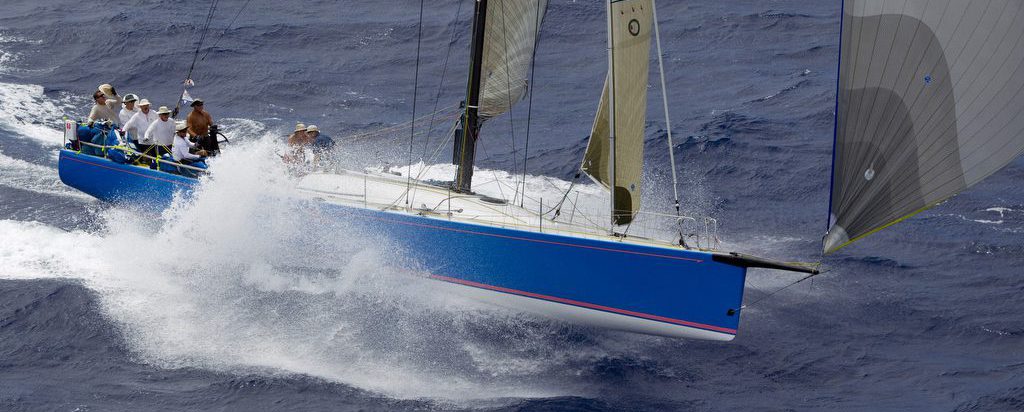
Win Long-Distance Yacht Races
Plan your route on a graphical chart-based interface. View boat performance data (polar charts). View weather forecasts (GriBs). Optimize your route using performance and wind data. Analyze how much flexibility you have to choose different fast routes. Track competitors. Interface to your GPS.
A Freeware Navigation Tool
Compare to commercial software such as Expedition or Deckman . Designed for use onboard with limited internet connectivity. Support for Sail Online virtual racers. Bluewater Racing uses high-quality, free, publicly available data from NOAA and various universities for its charting and weather routing.
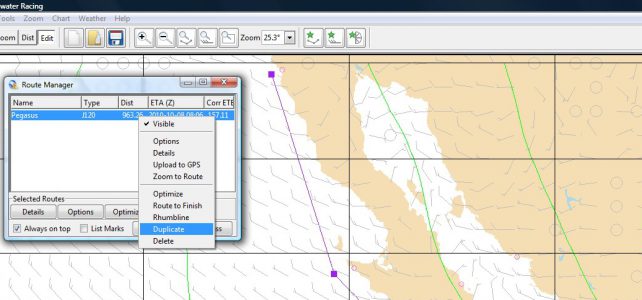
Check it Out
Take a quick tour of Bluewater Racing with the online tutorial , or check out the manual . Visit the online forum with questions or suggestions.
Sail fast now!
Available for Windows and Mac OSX.
Recent News
- JUNO wins in Transpac 2023
- Version 2.50 Available
- Version 2.45 Available
Support Bluewater Racing
If you find the software useful, please contribute what you can.
Boat Data and Polars
- your cart is currently empty
- Regatta & Offshore Racing
- Maritime transport
- Test our products
- Our video tutorials
- Setup & Updates
Optima, speed polars of a sailboat
The indispensable tool for creating polars actual sailboat..
Show laylines, know the target speed of the boat and the angle that achieves the VMG or calculate a route, it is all possible thanks to Adrena essential navigation polars.
So how do you create and use a polar in Adrena? Several options are available to users…
Calculate the polar
Optima, the calculation tool integrated into Adrena software, uses data recorded automatically during navigation to establish the polar curves of the boat. Rare feature among navigation software, this powerful tool provides excellent accuracy for the display and use of the actual performance of the boat. The calculation process is divided into three steps:
- the load of the tracks used for the calculation. It may be all the recorded data or only a portion (eg only regatta tracks)
- the calculation of the curves by the software and any manual corrections
- the registration of the polar file newly calculated.
We can thus create different files to have a polar “crew” or “cruising solo” or even depending on the sea state (dedicated buttons are provided for this).
Activate a polar
Once the boat’s polar file is created, the crew can immediately use its data contained by activating the polar in Adrena software. In the menu “Tools> Activation polar” software provides the ability to activate a different polar for the start phases and phases of navigation. If you do not have a specific polar for each phase, then the same file is activated in both case.
Theoretical polar and VPP, use them as reference!
In some cases, there is only theoretical polar – or VPP – recovered from the manufacturer or the architect who designed the boat. It is a good base to start racing and get performance values around the potential of the boat. These polars can be activated to be used immediately. When there is not enough tracks recorded to cover all ranges of use of the boat, it will be useful to complete the “holes” left by the lack of data in certain circumstances. Thus the active polar initially based on theoretical data of the polar reference will be refined over the navigation by the speed recordings.
In Optima menu it is possible to define a reference polar, it is not the software active polar. It is used in the window “calculation of polars”, by ticking the box “replace missing data with reference polars” to complete the calculation.
Theoretical polar Missing data inserted Final calculated polar
Difference between theoretical and calculated polar
Theoretical polar Calculated polar
What if I do not have any theoretical polar ?
When the theoretical polars are missing, last solution is based on mariner’s experience and knowledge of his boat : it is to write its own polar. From an Excel pivot table, you define the boat’s target speeds according to the wind angles and the wind speed.
The table should be as following:
The table should star tat first line, fisrt column of the first sheet of your excel file.
Save your file in text format (tab delimited) ( .txt )
Retrieve in Windows explorer the file and select it. Modify the extension from « .txt » en « .pol »
Then, you can activate the polar in Adrena.
The description of how to use those tools can be found in the user manual delivered on every ADRENA software CD or in our website in the FAQ .
How Adrena is using the polars?
Laylines display on departure line
Layline display and VMG heading to waypoints
Performance data display
Target duration display
Weather routing calculation
Written by Adrena
Adrena is a company providing a large range of products - Octopus, First, Standard and Pro to the world of sailing. Thanks to a complete and progressive offer that fits any level of sailing, our software satisfies the amateur through to professional teams alike.

- Forums New posts Unanswered threads Register Top Posts Email
- What's new New posts New Posts (legacy) Latest activity New media
- Media New media New comments
- Boat Info Downloads Weekly Quiz Topic FAQ 10000boatnames.com
- Classifieds Sell Your Boat Used Gear for Sale
- Parts General Marine Parts Hunter Beneteau Catalina MacGregor Oday
- Help Terms of Use Monday Mail Subscribe Monday Mail Unsubscribe
- Thread starter dehler25
- Start date Nov 4, 2016
- Hunter Owner Forums
Anyone come across Polar specs on Hunters? I have noticed that there are weather routings that can actually use the info to create better expectations.
Went looking a while back and never did find a single one. Clearly polars are a boat-sail inventory/age-crew skill sort of thing which is why I don't think any body bothers making a "standard" polar for model x. Your best bet is to get some circular graph paper and start recording data. One page for each main-foresail combination is my recommendation as it is going to take a while to get enough data to tell anything. If you try putting it all on one graph you (well I would) eventually forget to label the data points and have to start over. FWIW
OR You got me interested again. This app can "learn" the polars for you boat!!!! http://www.sailtimerapp.com/MoreDetail.html good luck
Screen Saver
Hi.. Sorry the late reply I just saw this.. Yes I to would be interested. Raytech (Full licenced version) fully connected can actually generate these for you but it takes time and everything needs to be right. I have done it a couple times and still need to work on it. For me I need to boat clean and my typical sailing conditions with no added current so that these things can be taken into account in real time. Im not sure how or with what you intend to use your Polar when you get it but Raytech is very good but also very complicated. Once you have this information you can also use the Laylines and VMG becomes much better. Hunter by rights should supply the Polar, but I when I approached them they maintained this was proprietary design information, so it does exist and they do or at least did have it. Perhaps a few more approaches to Hunter might see this change, or perhaps someone knows someone who can add some weight. Good luck
I guess at the end of the day I prefer a level of simplicity. I had thought the Polars were more a function of hull and keel design rather than coupled with the specific sails that were flying.
Yea Polars are not so complicated in there us, and yes you are 99% right its about hull and keel, but also speed. However when sailing of course the Hull and shape in the water changes (ie water line length for example), as does the power provided by the sails, the sea and the current. Polars are one of many factors and typically the only one not readily available to tell you the best way to go, to make the best VMG. So when you have or create polar, and with some software you add this to known SOG (for your boat) to a given wind angle and sail set, then combine that with the current, which is already known, the wind strength and direction ( already known), you now have 99% of the tools to produce the best possible VMG to a known way point or route. It is interesting and I am by no means an expert, but it did teach me not to pinch the wind as much, and has given me a vague rule that in my case for every 10 degress I am off my run line I must go 1 knot faster to arrive at the same time. If you have the current and tides and your software can deal with all of this, you will find you will leave at different times and travel in different directions to that which you probably otherwise would have gone. I need to play a lot more in this area, and typically only do it for interest at this time. Im in no hurry.
Polars created by a boat's designer are done so by modeling the boats performance with a Velocity Prediction Program (VPP), a suite of software that models the hull, appendages, rig, and upwind and downwind sailplan. It calculates flat water boat speed over a range of wind angles and speeds. Racers and performance oriented sailors like that because it gives them targets, in particular upwind speed and downwind angles. Downwind values are meaningless if you are not flying a spinnaker designed for your boat. If you have polars for your boat, you will need great sails, a correctly sized crew, and sail well to hit them. There are ways to generate polars from observer performance, but this can suffer from GIGO (garbage in - garbage out) where if the input is not good; measured performance or how you're sailing; the polars will be bad. But its a place to start. You CAN have polars created for your boat; but its not cheap. If you are lucky, someone has had it done for a sister ship... this happens if someone wants to seriously race it. Polars ARE needed for weather routers to work; and there are some good ones for the ipad and the like. But remember again, that route will be meaningless if you are not using spinnnakers when sailing off the wind.
I used a NMEA2000 to wifi converter to gather data on my laptop to help verify and calibrate the polars on my Catalina 27, here is a plot for boat speed upwind with a 150% Genoa. You can find links to a lot of polar data (including non-spinnakers polars) at https://sailingpolars.com/
Attachments

flightlead404
dehler25 said: Anyone come across Polar specs on Hunters? I have noticed that there are weather routings that can actually use the info to create better expectations. Click to expand
The new PredictWind DataHub is supposed to generate polars for your boat by gathering data over time. A friend installed one on a sister boat to mine and is using it now with Starlink. He's talked to PredictWind tech support and it's supposed to even know when you're motoring vs sailing by measuring voltage, so it ignores data when motoring to keep from polluting the sailing polar data. Supposedly PredictWind will then use your boat's collected polar data to do your weather routing. Will be interested to see how this goes. The Raymarine Axiom has a database of polars in there, but for Hunters it's not a large sampling of boats - he's using the old Hunter 40.5 on the chartplotter while he generates his own polars for his MH40 via the DataHub. DataHub · PredictWind
The new Raymarine Axiom have polars in their data base it has polars for my Hunter 35.5 and it’s excellent to use LIGHTHOUSE VESSEL POLAR MANAGER Axiom displays running LightHouse 4.5 or higher include over 500 sets of Polar Performance Data for popular sailing hulls preloaded. If your hull is preloaded in Axiom, choose your yacht brand and model and enjoy the advanced features polar performance data enables, such as tack angles to achieve optimum VMG upwind and downwind, time and distance to tack, and the percentage of polar boat speed being achieved. The latest list of Axiom's preloaded Performance Polars in the LightHouse operating system is available in this knowledgebase article.

Polar Performance Data | Online Guides | Raymarine
- This site uses cookies to help personalise content, tailor your experience and to keep you logged in if you register. By continuing to use this site, you are consenting to our use of cookies. Accept Learn more…

Boat polars describe your boat speed and true wind angle in any given weather situation. Setting the polars up in your PredictWind account is important for an accurate weather route. You must set the polars up in your account before using the weather routing and departure planning tool on any of the PredictWind platforms.
Setting up your Polars in your PredictWind account must be completed on the PredictWind forecast website or within the PredictWind App. Once you set these up, they remain in your account for use on all platforms, including the Offshore App.
See below the wind angles we use to define upwind/reaching/downwind.
% time upwind = True Wind Angle is 55 degrees or less. % time reaching = True Wind Angle is between 55 and 135 degrees. % time downwind = True Wind Angle is 135 degrees or more.
PredictWind App
Under Weather Routing , click on Sail Routing or Power Routing .
Tap on the Settings cog, then Boat Polars .
Under Boat type , select from Predefined, Power / Sail, Advanced or AI Polars . Advanced and AI Polars require initial setup on the PredictWind Forecast website.
Make your selection.
Tap back to go to the weather routing map.
Tap on Calculate to validate your polars in your account; you must run a weather route after selecting.
Forecast Website
On the forecast website https://forecast.predictwind.com/ go to Weather Routing , select Sail Routing or Power Routing , then the Routing preferences tab.
In the Routing preferences, there are four options for setting up your Polars: Predefined, Power/Sail, Advanced and AI Polars.
We have a large selection of boat designs with their own complete set of polars; you can select your type of boat or one that you know has a similar performance to your boat.
Sail polars
Sail Polars are very simple to set up and are suitable for cruising boats, where you cannot select a predefined polar. Enter your boat speed at 50. 90. And 160 degrees true in average 15-knot wind speed conditions. We assume this is the max speed for the vessel, and the boat speed decreases as the wind drops.
Advanced Polars
Advanced polars are great if you have a performance yacht and wish to define your polars for all points of sailing with different sail combinations. The format for Advanced polars can be seen here. You can add more columns and rows. (Do not copy in the TWS, TWA and Boat Speed labels). The first TWA column is your upwind target; the last TWA column will be your deepest downwind angle.

We now have a Polar Import Feature . On the Advanced Polar section of the Weather Routing Preferences, you can import a '.txt' file (PredictWind format) and a '.pol' format polar. The imported polar will automatically fill the Advanced Polar Text Box. '.pol' polar files will be converted to the PredictWind format before being pasted into the Text Box. You can then calculate a route as usual using the imported advanced polar.

To use AI Polars, you must have a DataHub and PredictWind Professional Forecast subscription. Select AI Polar on the Routing Preferences page, then select Use my latest AI Polar to run future routes from DataHub collected Polar Data. To get started, click Edit Base Polar, then set your boat's predefined settings as a base data set to be improved upon and click Save Base Polar .

For more information about AI Polars , please see this article .
Power Polars
If you are using the weather router for a Power vessel, then use the Power option.
The optimal route will deviate based on the weather and waves to minimise the total fuel used over the whole route. In the Summary Tables on the Wind and Summary tabs, you'll find a row detailing the fuel used for each route.
Other Notes
For all polar setups, Professional package users can also set up a Wave polar to adjust their boat's performance in different wave conditions. It is simply a % of your base polar and will be calculated using the wave conditions from the forecast.
All other routing preferences, which include Motoring settings, Comfort settings and tidal and Ocean currents, can be adjusted in each platform, but they do not transfer across platforms.
Once you have set up your Polar preferences, you must Calculate a route to save the polar in your account.
After calculating a route, you can see the weather routing results. Please take some time to analyse the results in the tables. The wind tab will give all the points on the route, comparing the wind speed to boat speed at various angles and speeds. It is important to check your routing results to your actual boat speed. You can go back to your preferences and adjust your polars if necessary.
Please click here to contact us if you need more help or information.

IMAGES
VIDEO
COMMENTS
Polar diagrams for sailyachts with ORC certificates. ... search by sailnumber, name or type or select a random boat. Questions/suggestions? Contact me on Twitter or GitHub. All data is fetched from ORC.org. Random boat. Greatest maximum speed (kts) POL20180 I LOVE POLAND 24.52; USA/CAY007 Vesper 19.67; GER7111 ...
Seapilot uses the polar diagram to compute the fastest choice of path at a given forecast for wind (and current). The polar diagram is imported to Seapilot as a polar file in text format (.txt, .csv or .pol). The name of the boat type or the specific boat is suitable to use as a name of the file (for instance J80.txt).
Download polar files If you don't want to create your own polar file, download all polar files here >> . For download: Right click on the file "Save file as".
Polars & Performance. Below is a collection of polar diagram from various sources. Mostly in numerical format to easily plug into routing software. They're published here just to play around with. For serious/real use you should get a real one for your specific boat. Also some links to tuning guides and other perfomance related info.
To read the Leopard 45 polar diagram shown here, start by looking at one of the colored curves — say the blue line, which tracks the mainsail and jib sail plan. As you trace that curve through different TWAs, you can see the predicted boat speed with that sail configuration. At 50 degrees TWA, for example, your Leopard 45 should be making 10 ...
A polar diagram is a graphic presentation of a sailboat's sailing performance in various wind conditions. The same information is also often presented in the form of a table or spreadsheet, which is how the data are originally collected or computed, which in turn is then plotted on a polar diagram as shown below.
5 tips on developing your polar diagrams to improve your boat speed. To help minimise your losses you need to sail your boat to its target boat speeds. Jonty Sherwill asked designer Mark Mills for ...
A properly trimmed sailboat will track this C curve. You can read the Polar Plot by placing the boat on the C curve and tracing around the concentric arc to determine the speed of the boat. For example, click on 60, this will point the boat so that it is sailing at 60 degrees off from the wind direction.
Polar diagram (sailing) Downwind polar diagram to determine potential yacht speeds at various wind speeds for a sailboat. A polar diagram, or polar plot, is a graph that shows a sailboat 's potential speed over a range of wind speeds and relative wind angles. [1] It normally consists of the right side of a line chart with the radius ...
Use this sample polar table spreadsheet to upload your Polar Performance Data to Axiom. Polar data can be sourced from many locations. Your boat manufacturer (which is the preferred source), a class association or members forum, a rating certificate, or put together by the owner if it is a very old hull design or a one-off boat.
PredictWind will then track your boat's real-time data and automatically create an optimised boat polar for your unique vessel and sailing style. More than just wind AI Polars also factor in wave conditions (wave height, period & direction) to create a hyper-accurate polar that is a realistic representation of the boat's offshore performance.
The polar plot is the navigator's friend. It's essentially a graph that shows how fast your boat can go in a range of wind speeds and angles. Polar plots are published by each manufacturer for each model of boat with their various sail plans. Below is an example of one particular boat for three true wind speeds; 16 knots, 12 knots, and 8 knots.
SailboatData.com …is a database that contains information on over 9000 production and semi-production sailboats dating back to the late 1800's. COMPARE BOATS To compare up to three boats at one time, click the (+) Remove a compared boat by clicking (-)
Pro navigator Stan Honey explains how using your boat's polars offshore can get you down the track faster. "From the Experts" in our June 2008 issue. In the April '08 issue we covered how to use ...
Two sets of Sample Polar Data and boat geometry are included, or you can read your own polar data from comma-delimited files. Polars Data must be formatted like this sample data, as follows: first line is a list of wind speeds: 4,5,6,7,8,9,10,12,14,16,20,25;
Win Long-Distance Yacht Races. Plan your route on a graphical chart-based interface. View boat performance data (polar charts). View weather forecasts (GriBs). Optimize your route using performance and wind data. Analyze how much flexibility you have to choose different fast routes. Track competitors.
Beneteau First 36.7 & 260 Minneapolis MN & Bayfield WI. Mar 26, 2018. #1. It's out of beta now. An on-line VPP system Avalon Navigation (a French Company) will do a very decent job of creating polars for your boat, IF you can provide the detailed measurements required for hull, crew, and sails. Hull is by far the most critical and hardest.
Technical Data Marine Resources Racing Resources @L-36 Top Videos L-36 Owners Roster Contact Boat Data and Polars . A35 Polar; A40rc Polar; Albin Nova Polar; Arcona400; Arcona430 Vpp; Arcona460; ... First317 Boat Mod.url; First317 Polar; First347 Performance Prediction; First367 North Tuning Guide;
Once the boat's polar file is created, the crew can immediately use its data contained by activating the polar in Adrena software. In the menu "Tools> Activation polar" software provides the ability to activate a different polar for the start phases and phases of navigation. If you do not have a specific polar for each phase, then the ...
Coming Soon - a leading source of accurate sailing polar data and polar diagrams. Using AI and Machine Learning to combine Velocity Prediction Program (VPP) theoretical targets with actual measured boat speed data Sailing Polars plans to provide realistic predictions of boat speed and VMG that can easily be imported into weather routing ...
Axiom displays running LightHouse 4.5 or higher include over 500 sets of Polar Performance Data for popular sailing hulls preloaded. If your hull is preloaded in Axiom, choose your yacht brand and model and enjoy the advanced features polar performance data enables, such as tack angles to achieve optimum VMG upwind and downwind, time and ...
Select AI Polar on the Routing Preferences page, then select Use my latest AI Polar to run future routes from DataHub collected Polar Data. To get started, click Edit Base Polar, then set your boat's predefined settings as a base data set to be improved upon and click Save Base Polar.
Select a boat from the list below, then edit the specifics below or add your own data: MODEL. LOA. FIRST BUILT. 11 METER. 33.8 ft / 10.30 m. 1990. 110. 24 ft / 7.32 m.